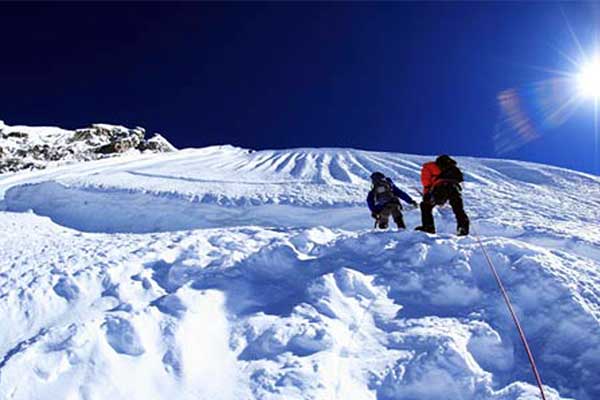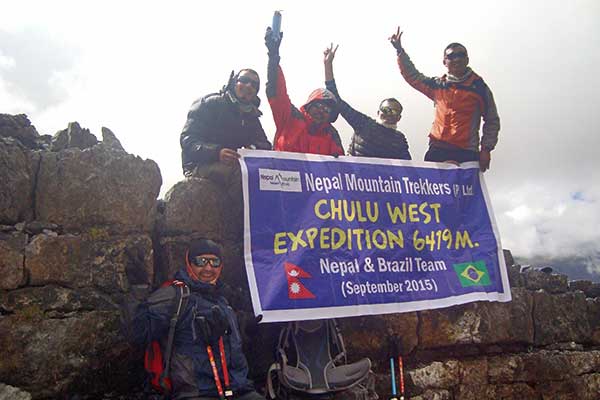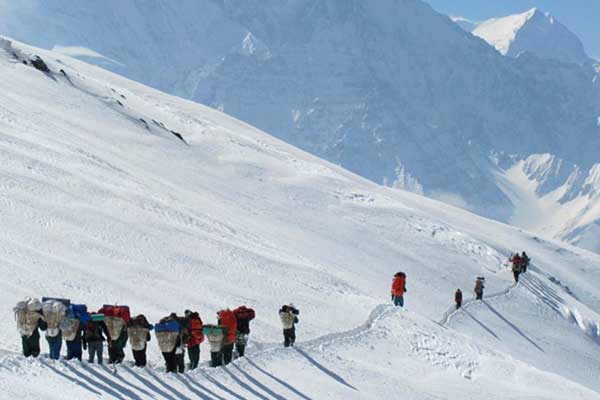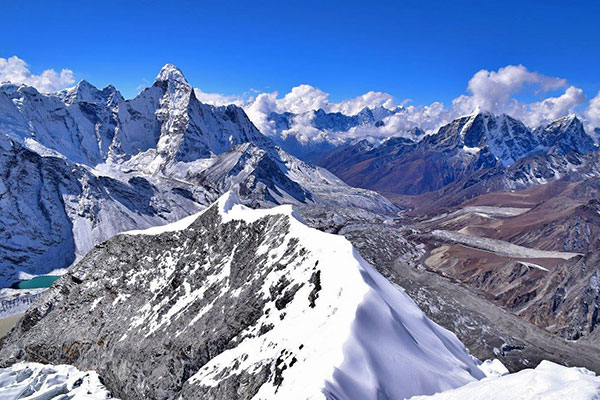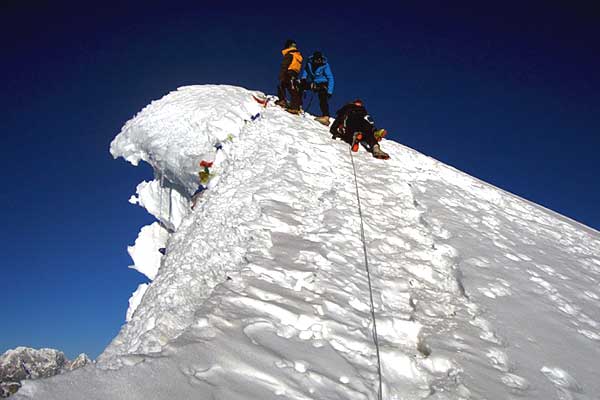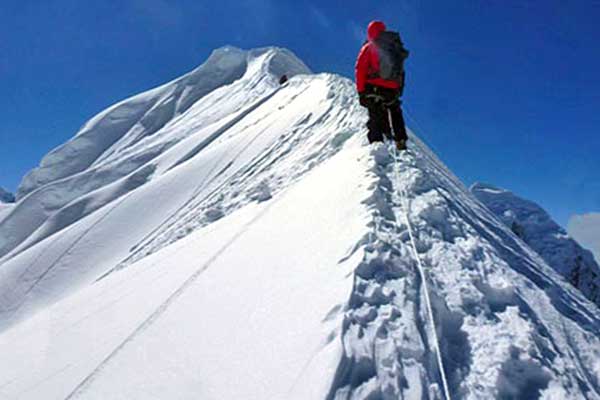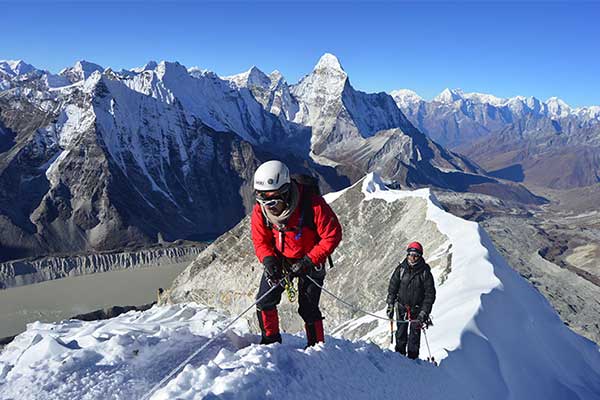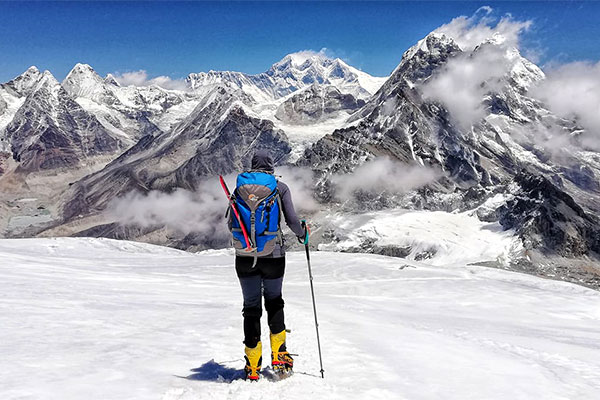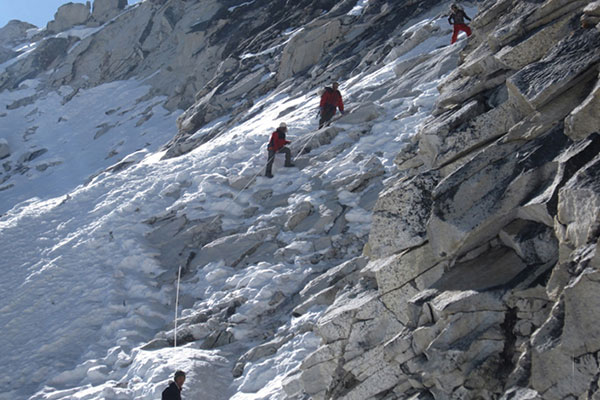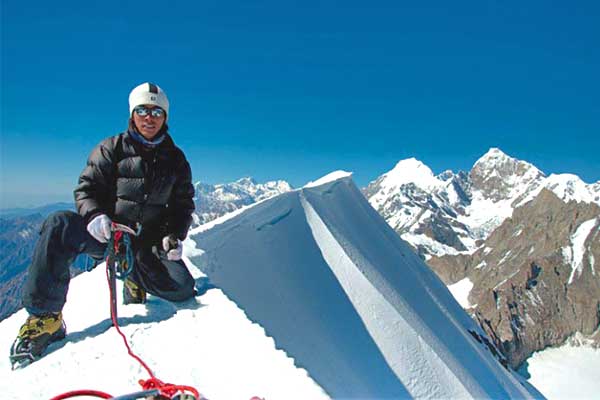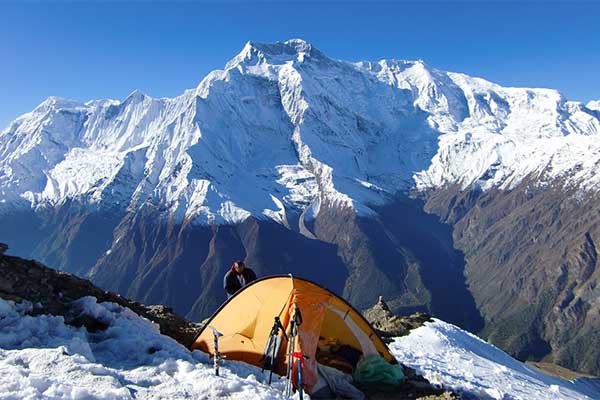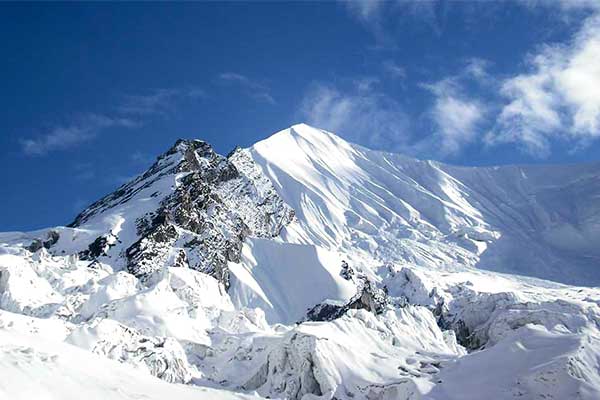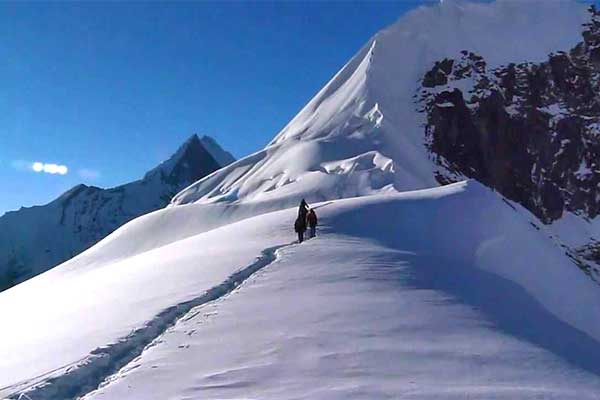Overview
Duration :
23 Days
Secondary Activity:
Nature and Culture
Max altitude :
5,600m/18,372ft
Transportation:
Private Vehicle and Domestic Flights
Trip ends in:
Kathmandu
Accomodation:
Tea-House and Tent Camp
Primary activity:
Trekking and Climbing
Group Size:
Min. 2 pax
Country:
Nepal
Trip starts from:
Kathmandu
Diffficulty:
Strenuous Plus
Meals:
Nepali and Continental
Best Season:
Autumn and Spring
Trip route:
Kathmandu - Lukla-Phakding - Namche Bazaar- Marlung-Renjo La-Gokyo-Gokyo Ri-Thangnak- Cho La-Dzongla - Lobuche Base– High camp– Summit day-Lobuche base camp-Dingboche- Chhukhung-Island Peak Base camp-Pangboche-Namche Bazaar-Kathmandu
Trip introduction
Two-Pass plus Two Peak Climbing is a challenging adventure in the popular Everest region of Nepal. In this adventurous journey, we accomplish two passes of Renjo La pass and Cho la pass then head towards two peaks of Lobuche and Island peak. It would be a great overall exploring opportunity of Everest region from great Himalayan views, Sherpa culture to crossing high passes and peak climbing adventures that takes our breath away.
Two-Pass plus Two Peak Climbing starts after we take a flight to Lukla and trek towards Phakding. Making our way through beautiful rhododendron forests, Sherpa villages we arrive at Namche Bazar where we take our first acclimatization. Then we head towards Marlung, cross Renjola pass, arrive at Gokyo, and ascend Gokyo Ri to view amazing panoramas of Everest Himalayan ranges. Further, we head towards Thagnak, cross Cho la pass, and arrive at Lobuche base camp via Dzongla. After we summit Lobuche, we descend towards Dingboche, Chukkung, and get ready for our peak climbing adventure at Island peak. Great panoramic views of Everest Himalayas are seen from the summit. In this way, we trek towards Pangboche, Namche, Lukla and finally board a flight back to Kathmandu.
Two-pass plus two-peak climbing is an extreme adventure in the popular Everest region of Nepal. You must possess previous high-altitude trekking experience before joining this trip. Join 2 passes plus 2 peak climbing with Nepal Mountain Trekkers. Contact us for booking and further information.
Special Note:
If this itinerary doesn’t suit your requirement or if you want to customize it, please feel free to contact us. This trek could be customized as per your required time frame and budget limits.
Overview
-
Day 1Arrival in Kathmandu (1,300 m/4,264 ft):
-
Day 2Kathmandu: Sightseeing and Trek Preparation:
-
Day 3Kathmandu – Lukla [2,840 m/9,320] – Phakding [2,652m/8,700ft]: 40 minutes flight, 3 – 4 hrs trek (Trekking times only):
-
Day 4Phakding – Namche Bazaar [3,440 m/11,280 ft]: 5 – 6 hrs trek:
-
Day 5Namche Bazaar: Rest day:
-
Day 6Namche – Marlung [4,210m/13,810 ft]: 7 – 8 hrs:
-
Day 7Marlung – Renjo La [5,360m/17,585 ft] – Gokyo [4,800m/15,580 ft]: 7-8 hrs:
-
Day 8Rest day in Gokyo – Gokyo Ri [5,357m/17,575 ft]: 4-5 hrs (Choice for fifth lake [5,367m/17,609 ft]: 6-7 hrs):
-
Day 9Gokyo- Thangnak [4,680m/15,350 ft] : 2-3 hrs:
-
Day 10Thangnak – ChoLa [5,368m/17,611 ft] – Dzongla[4,830m/15,850 ft]: 8-9 hrs:
-
Day 11Dzongla – Lobuche Base Camp: 3-4 hrs (Preparation day):
-
Day 12Lobuche base camp – High camp [5,800m/19,028 ft]: 3-4 hrs:
-
Day 13High camp – Summit day [6,119m/20,075 ft] and back to Lobuche base camp: 8-10 hrs:
-
Day 14Lobuche base camp – Dingboche [4,360m/14,300 ft]: 4-5 hrs:
-
Day 15Dingboche – Chhukhung[4,730m/ 15,519 ft] : 3-4 hrs:
-
Day 16Chhukung to Island Peak Base camp (5,200m/17,060ft): 3-4 hours:
-
Day 17Prepare Climb training on Island Peak Base Camp:
-
Day 18Island Peak Base Camp to Summit and back to Base Camp (5,600m/18,372ft) 10-12 hours:
-
Day 19Island Peak Base Camp to Pangboche (3,985m/13,074ft) 5-6 hours:
-
Day 20Pangboche to Namche Bazaar: 4-5 hours:
-
Day 21Namche Bazaar to Lukla: 6-7 hours:
-
Day 22Fly to Kathmandu:
-
Day 23Departure Day:
Detail Itinerary
Day 1 : Arrival in Kathmandu (1,300 m/4,264 ft)::
Upon your arrival at the Tribhuvan International Airport in Kathmandu and after you complete the formalities at the customs; you shall then be greeted by a representative of Nepal Mountain Trekkers. From the airport, s/he shall transfer you to the hotel for your stay. After checking in the hotel, get rest for your jetlagged body, and later on, you may stroll around in the streets of Thamel and nearby areas. Enjoy the authentic dinner at the hotel and prepare for the exploration of the medieval heritage of Kathmandu. Stay overnight in Kathmandu.
Day 2 : Kathmandu: Sightseeing and Trek Preparation::
Today we shall dedicate ourselves to the preparation of the trip to the Everest region for the ascent over a couple of peaks and passes. We shall also explore the medieval heritage of Kathmandu. Pashupatinath Temple, one of the most sacred Hindu temples around the world at the bank of the holy Bagmati River, the stupas of Swayambhunath (the ancient stupa famous for divinity, whitewashed monasteries, and the marvelous view of Kathmandu valley), and Boudhanath (one of the biggest stupas in the world with several ancient Buddhist heritages and regular chanting of Buddhist mantras) are the star attraction for today. We may also explore the historical Durbar Squares in Kathmandu and its neighboring city of Patan which are famous for Royal Palaces, ancient temples and architecturally important heritages, intricate carvings, stone taps, and many more. Later in the afternoon interact with the climbing and trekking guides for the necessary information regarding the adventure and get your queries cleared as well. Overnight stay in Kathmandu.
Day 3 : Kathmandu – Lukla [2,840 m/9,320] – Phakding [2,652m/8,700ft]: 40 minutes flight, 3 – 4 hrs trek (Trekking times only)::
Today we shall finally embark on the adventure into the Everest region for our adventure. We shall take in the flight early morning to Lukla, the gateway to the Khumbu region, above the breathtaking green lush hills and valleys, changing landscape, and the view of majestic snowcapped mountains. After landing in Tenzing-Hillary Airport, surrounded by high mountains, we shall meet other members of our expedition. After packing bags for the adventure ahead, we shall first have a short hike before descending to the main trail of our expedition near Chheplung village past Mani walls, stone walls, and small settlements. Continuing along the bank of the perennial Dudh Koshi River we shall trek across several suspension bridges through lush forest, smaller settlements, prayer wheels, and the view of mountains such as Kusum Kanggaru before we reach scenic Phakding, located on the bank of Dudh Koshi River. Through the greenery of the trail and looked over by the majestic peaks, this is an introductory trek in the region to the trekkers. Stay overnight in Phakding.
Day 4 : Phakding – Namche Bazaar [3,440 m/11,280 ft]: 5 – 6 hrs trek::
One of the most scenic sections in this trek, today’s journey shall head for the colorful Sherpa hub of Namche Bazaar. Starting with the trail along the mighty river past the ancient gompa across a suspension bridge we move ahead to the Benkar valley past a beautiful waterfall. Gradually ascending in the trail, we reach Monjo, the gateway to Sagarmatha National Park, across several suspension bridges and past many Chortens. Through the village of Jorsale, we reach Larja, the confluence of Dudh Koshi and Bhote Koshi rivers which we shall be crossing over a vertiginous suspension bridge. Ahead is a steep trail of around an hour which shall lead us to our destination of Namche Bazaar. En route Namche, we also get the view of Everest from a ridge crest. Overnight stay in Namche Bazaar.
Day 5 : Namche Bazaar: Rest day::
Today we shall be having a rest and acclimatization day in Namche Bazaar at 3,440m. Experts suggest being active and moving during the rest day as well. We shall thus explore the several sites in and around the colorful village of Namche. The Sherpa Museum in Namche provides the visitors with the information about flora and fauna of the region, the history of mountaineering, the lifestyle of the locals, and various other important aspects of the region. There are some popular destinations for day hikes for trekkers. Hike to the Everest View Hotel to enjoy an up-close view of the mighty Everest and other snowy mountains including Ama Dablam and other sibling peaks. Other hiking destinations are the villages of Khumjung (famous for the ancient monastery with Yeti scalp and the school built by Sir Edmund Hillary) and Khunde, and a relatively long trail to Thame is also in the choice of trekkers acclimatizing in Namche. Stay overnight in Namche Bazaar.
Day 6 : Namche – Marlung [4,210m/13,810 ft]: 7 – 8 hrs::
On a long trekking day, today we shall head on towards the Gokyo valley and take on the route used by ancient traders to trade with Tibet. Through the forest adorned by pine and rhododendron, we shall traverse through small villages of Phurte, Samsing, and Thesho. Watch out for Himalayan Thar, Impeyan Pheasant, and Musk Deer around the area before you reach Thamo village. Known for a nunnery monastery above the village, we trek ahead in the trail through a powerhouse as we ascend to Thame village after crossing the mighty Bhote Koshi River. Following the upstream of Bhote Koshi River on its left bank, we continue to navigate through small villages such as Chanakpa, Taranga, and others before reaching Marlung, the destination for today. En route, we trek past summer settlements, beautiful scenery, and landscape. Taranga, believed to be the home to abominable snowman called Yeti and the home to the world’s best potatoes is the major attraction of this section of the trek. Stay overnight in Marlung.
Day 7 : Marlung – Renjo La [5,360m/17,585 ft] – Gokyo [4,800m/15,580 ft]: 7-8 hrs::
Pass (5,360m) and reach the scenic Gokyo valley. Trekking along the right bank of Bhote Koshi River we move ahead as the settlement becomes sparse and terrain more difficult. Trekking through Lumde village we branch off towards the Renjo La Pass little ahead of the village. In a trail section with steep ascent coming more often, we shall keep moving slowly and steadily towards the pass. On reaching the top of the pass past the glacial lakes, we get to watch an excellent scenario. Panoramic views of the Himalayas including Cho Oyu Peak, Everest, Pumori, Makalu, and other 8000 meter peaks to the east and the Gokyo valley and glacier are worth the strain endured to make it to the top of the pass. Descent from the pass is steep descent immediately after the summit of the pass, which becomes more gradual as we move ahead to the Gokyo lakes past the Gokyo glacier. After a strenuous day, take a rest in the teahouse today as we shall explore the beautiful valley the following day. Overnight stay in Gokyo.
Day 8 : Rest day in Gokyo – Gokyo Ri [5,357m/17,575 ft]: 4-5 hrs (Choice for fifth lake [5,367m/17,609 ft]: 6-7 hrs)::
Today we shall have a rest day in the marvelous Gokyo valley and explore the surrounding areas. The main activity shall be the ascent to Gokyo Ri, also nicknamed as The other Everest by some explorers. Starting early from the overnight stay at Gokyo, we shall climb to the scenic peak gradually depending upon your level of acclimatization and fitness. Walking along the rocky terrain and gaining altitude makes the climbing bit difficult, though you won’t find the climb much technical in itself. Of course, walking here isn’t the same as walking at sea level. Reaching the top of the peak is a marvelous experience. A view considered by many as the best Himalayan view, we can witness the range of 8000m peaks proudly standing which include mightiest Everest (8848m), Cho Oyu (8153m), Lhotse (8501m), Makalu (8475m), as well as other peaks such as Cholatse (6440m), Tawache Peak (6542m), Thamserku (6808m) and several other named and unnamed peaks. Below the Gokyo Ri we find Ngozumpa Glacier, the largest glacier in Nepal, stretching leisurely and the view of beautiful Gokyo lakes add beauty to the scene. We shall trek down the summit gradually to the Gokyo village for refreshment and much-needed rest.
Depending on your fitness level and ability to continue further, we may also hike to the glittering and beautiful Fifth Lake, one of the six glacial lakes in the Gokyo valley, after descending from the summit of Gokyo Ri. Stay overnight in Gokyo.
Day 9 : Gokyo- Thangnak [4,680m/15,350 ft] : 2-3 hrs::
After strenuous trekking in this truly beautiful valley, we shall today embark on a short trek to the Thangnak across the Ngozumpa glacier. We continue our trek from the Gokyo village at the bank of Dudh Pokhari, also known as the third lake, and round the lake, our downhill walk continues along the glacial moraine of the Ngozumpa Glacier. As we continue our walk, we reach the second Gokyo lake connected to the Third Lake by a small stream and further on to the First Lake near which the trail turns towards the glacier. The view of Cho Oyu and other peaks is constantly there to entertain us during our trek. We now walk over the lateral moraine of the glacier and then over the glacier itself as we cross it to reach the destination for today, the settlement of Thangnak. Walking over the majestic glacier, where the sound of rocks being crushed under the glacier is a thrilling experience for any explorer. After a relatively short trek, get prepared for an ascent to another challenging pass, the Cho la Pass. Stay overnight in Thangnak.
Day 10 : Thangnak – ChoLa [5,368m/17,611 ft] – Dzongla[4,830m/15,850 ft]: 8-9 hrs::
On another challenging day, we shall today cross the demanding Cho La Pass and reach the Dzongla village. For this, we shall start early when the weather is stable. Slowly ascending on the tough terrain we reach the base of the pass. From there the ascent is steep and the walk is on the glacial transverse. Through the ravine and rocky trail, we reach the peak of the pass through the side of the frozen lake. From the top of the pass decorated with prayer flags, we have a magnificent view. The beautiful Ama Dablam dominates the neighboring snowcapped peaks on the south while the Cholatese Peak stands proudly on the south and the peaks of Lobuche East and Baruntse observes us from our right direction. The descent from the summit is also challenging as we cross some crevasses before we reach the destination for today, the settlement of Dzongla. While going up to the summit of the pass and coming down from it, the steepness of the trail and ice grease cause problems for the trekkers. Trekkers are suggested to take the guidance of an experienced guide while crossing this pass due to difficulty and the probability of getting lost, especially during the winter season. in some cases, the use of crampons may also be needed. Stay overnight in Dzongla which provides a view of the beautiful Pheriche valley and the majestic peaks including Ama Dablam, Cholatse, Lobuche, and others.
Day 11 : Dzongla – Lobuche Base Camp: 3-4 hrs (Preparation day)::
Today we shall start one of the most awaited climbs of this expedition, the ascent of the majestic Lobuche Peak. From Dzongla the trail to Lobuche Base Camp slowly becomes steep and gradually more dominated by rocky sections and big and small boulders. Coming from the height of Cho La pass, we are much acclimatized due to which the climbing becomes relatively less strenuous. Trekking past the small glacial lakes and lunar terrain, all covered with rock and ice, and the view of the snowcapped mountains including Ama Dablam, Thamserku, Cholatse, and others, we reach the Lobuche Base Camp. After reaching the camp and getting some rest we shall do some preparation for the climb ahead. Our experienced climbing guide shall provide some training on climbing techniques such as going up and down using rope, and use of climbing equipment and gears such as ice axe, crampons, harness, and so on. This shall increase confidence in climbers and enhance the chance of successful climb. Stay overnight in Lobuche Base Camp.
Day 12 : Lobuche base camp – High camp [5,800m/19,028 ft]: 3-4 hrs::
After eating breakfast, today we shall have a gradual uphill climb to the High Camp of the Lobuche Peak. During the climb of around 4 hours from the Lobuche Base Camp, we shall walk over the rocky moraine, snowy slope, and with the beautiful scenery of the high Himalayas surrounding the landscape and looking over our climbing trail. Through the rocky trail and snow, and past boulder we reach the High camp. We set our camp on a small expanse of snow and rock above a deep, blue lake and close to the mountain. Due to the limited space for setting up a sufficient number of tents, climbers have to share the tents. Tomorrow we shall have a very early start to the summit, which means today we shall go to sleep earlier than usual. Stay overnight in Lobuche High Camp.
Day 13 : High camp – Summit day [6,119m/20,075 ft] and back to Lobuche base camp: 8-10 hrs::
We start the climb for the summit of Lobuche East Peak very early from the southeast ridge of the peak, from our High Camp, which is the mixture of steep snow and ice. The climb from High Camp may require the use of ropes which shall be used as necessary. Slowly our climb reaches the plateau at 6,000m steadily and thereafter head on to an exposed ridge of the peak. Following further on the trail we ascend on the summit slopes and after approximately six hours of climbing, we shall reach the East Summit. This is generally the summit for most of the climbers, though the main summit is further ahead and requires some technical climbing which isn’t for the novice climbers. If you have the technical capacity you shall then head on along the summit ridge where there is a huge and steep drop on both sides of the ridge. With the help of ropes fixed on the trail, we shall reach the summit of the peak. From the summit, we have a marvelous view of peaks including Ama Dablam, Makalu, Everest, Lhotse, Nuptse, Pumori, Gyachung Kang, Cho Oyu, and others. We shall then return from the summit if we had been to the real summit or return from the eastern summit to High Camp and after packing up our equipment and luggage we shall return to the Lobuche East Peak Base Camp with a tired body and wary legs. Stay overnight in Lobuche Base Camp.
Day 14 : Lobuche base camp – Dingboche [4,360m/14,300 ft]: 4-5 hrs::
From Lobuche base camp we shall now head on to the high altitude settlement of Dingboche for our next summit of Island Peak. We start our day from the base camp and retrace our steps back to the main trail of Everest Base Camp trail and trek past the turquoise Chola Lake, beneath the Tahuche Peak and cross the trail leading to the Everest Base Camp at the settlement of Dughla. After crossing the Thugla River, we trek down through the valley and reach the settlement of Dingboche, a beautiful farming village. Dingboche is the major stoppage before we head for Chhukung, a settlement of few teahouses and the camp for Chhukung Ri as well as the last settlement before heading for the Island Peak. Stay overnight in Dingboche.
Day 15 : Dingboche – Chhukhung[4,730m/ 15,519 ft] : 3-4 hrs::
After breakfast, the walk towards the settlement of Chhukung shall begin. In this trek of around 4 hours, we shall be preparing for the ascent to the Island Peak as well. Descending towards the Chhukung valley we trek along the fast-flowing Imja River. We shall then move ahead in the trail past the Bibre, where the trail from Lobuche across mighty Khumbu Glacier meets the trail from Dingboche and the main trail from Tengboche. After some more trekking, we reach Chhukung village. A scenic village that provides the view of the fantastic snow and ice formation of Ama Dablam Peak and the wall of rock of the mighty Nuptse Peak. Stay overnight in Chhukung and marvel at the horizon filled by snowy mountain peaks.
Day 16 : Chhukung to Island Peak Base camp (5,200m/17,060ft): 3-4 hours::
From the overnight stay at the scenic Chhukung village, we shall now head for another ascent over the mighty Island Peak in our adventure. The destination for today shall however be the base camp of the Island Peak. Up the Imja valley and through the trail surrounded by glacial moraines and glaciers, snowy peaks, and glacial rivers our journey continues. The trail takes us past the section sandwiched by Lhotse Nup Glacier and Ama Dablam Glacier and ahead in the trail is the Lhotse Glacier after which we turn left over the glacial moraine of the glacier towards the base camp. Walking on the glacier itself with a glacial lake to our right, we slowly ascent to the base camp in a twisting trail. At 5200m, we have to use the Base Camp where we shall prepare for our final climb to the Peak. Stay overnight in Island Peak Base Camp.
Day 17 : Prepare Climb training on Island Peak Base Camp::
Today we shall be having some preparation for the climb over the summit of the Island Peak. The training today shall be under the guidance of our experienced climbing guide and we shall also be doing the final check of the equipment. Our climbing guide shall take us a little higher from the base camp to the slopes of the mountain and train us on using harness and crampons, tying knots on the rope and doing the ups and downs through the rope, using the other equipment that comes in handy during the climb to the peak. This training shall instill a lot of confidence in the climbers and prepare the trekkers better for the ascent. Stay overnight in Island Peak Base Camp.
Day 18 : Island Peak Base Camp to Summit and back to Base Camp (5,600m/18,372ft) 10-12 hours::
The ascent to the Island Peak shall start very early from the base camp. Climbers generally start at around 2 am and with the help of torchlight they head-on for the summit taking advantage of the stable weather in the peak. First, we shall head for the milestone of High Camp before going for the summit. After this gradual ascent to High Camp, we shall encounter the rocky steps that need some moderate scrambling and then head up through a broad gully at the top of which we shall begin our glacial travel. Proceeding to the steep slope of ice and snow we now have a strenuous section that requires the use of ropes fixed by our climbing Sherpa. This steep climb to the summit ridge shall take us to the exposed alpine ridge which shall then lead us to the summit. With the help of the ropes fixed and climbing equipment, we traverse to the summit of Island Peak. The breathtaking and panoramic view of the mountain peaks such as Lhotse, Ama Dablam, Makalu, and Baruntse is an exhilarating reward for the climbers. Retracing the same route we shall head back to the base camp of the Island Peak. Stay overnight in Island Peak Base Camp.
Day 19 : Island Peak Base Camp to Pangboche (3,985m/13,074ft) 5-6 hours::
After the climbing of the famous Island Peak and the Lobuche Peak a few days earlier, the trek is now in the ending phase. Today we shall head on down to the Pangboche. Through the trail overlooked by glaciers and surrounded by glacial moraines, we now descent to the small settlement of Chhukung before heading down to Dingboche in the same trail that we used to reach the summit of Island Peak. Ahead Dingboche, the trek continues along the mighty and fast-flowing Imja River and navigates through several small settlements, some sections of flat trail, a couple of suspension bridges, and through the alpine vegetation to reach one of the religious centers of the Khumbu region, the Pangboche village. A village with several Chortens, prayer stones, and an ancient monastery at a bit higher altitude, Pangboche is our destination for today. The gompa of Pangboche, positioned between the holy mountains of Khumbila and Mount Everest, is famous for the celebration Lama Dance besides being the oldest center for learning in the Khumbu region. Stay overnight in Pangboche.
Day 20 : Pangboche to Namche Bazaar: 4-5 hours::
Today our destination shall be the unofficial Sherpa capital of Namche Bazaar. In a trek of around 5 hours, we shall first hike to another famous settlement of the Khumbu region and a religious center, the settlement of Tengboche. This ascent takes us through a couple of suspension bridges, Musk Deer Trail that provides the opportunity of viewing the rare animals such as Musk Deer, Monal, Blue Sheep, and others, and the settlement of Deboche. Exploring the famous Tengboche Monastery, we descend to the mighty Dudh Koshi River through Phunke Tenga and reach the trail junction along with the stone steps. From here we navigate through the pine, oak, and rhododendron forest and the settlements of Sanasa and Kenjoma to reach Namche. En route, we also have the viewpoint of Everest and other peaks such as Ama Dablam, Lhotse Shar, Taboche, and others. Stay overnight in Namche Bazaar.
Day 21 : Namche Bazaar to Lukla: 6-7 hours::
In the last section of this adventure where you shall be trekking in the hilly terrain, today we shall be heading to Lukla. Trekking out of Namche we have a steep descent for about an hour with the view of mountains including the mighty Everest until we reach Larja bridge, over the confluence of Dudh Koshi and Bhote Koshi River. We exit the Sagarmatha National Park at Monjo and then past the Chortens, over suspension bridges we trek out of the Benkar valley. Through the trail surrounded by dense rhododendron forests, looked over by the humongous snowy peaks, and accompanied by the mighty rover far below the trail, we navigate through settlements of Phakding, Ghat, Nurning, Chheplung, and others before hiking shortly to the village of Lukla. Intermittently, we shall trek past the prayer wheels and Mani Stones, cross over suspension bridges festooned with prayer flags, marvel at the sight of beautiful waterfalls and lofty peaks such as Kusum Kangguru, Kongde Ri, and other neighboring peaks, and interact with the warm villagers as well as the train of fellow trekkers, porters, and guides. Stay overnight in Lukla.
Day 22 : Fly to Kathmandu::
After successful completion of a long and strenuous adventure in the Everest region, we shall today leave for the capital city of Nepal, Kathmandu. In an early flight from Lukla airport, we shall fly over lush valleys and hills, serpentine flowing rivers weaving those valleys, and the views of the snow-capped mountains watching over the vast landscape. After landing in the domestic terminal of Tribhuwan International Airport, you shall be transferred to the hotel. In the afternoon, you may go souvenir shopping for the near and dear ones back in your native place. If you wish to extend your stay, you may book other packages of ours. Stay overnight in Kathmandu.
Day 23 : Departure Day::
An exciting, adventurous, and memorable Two-Pass plus Two Peak Climbing comes to an end today. If you wish not to take other packages to extend your stay in this beautiful nation, our representative shall assist you with your departure by escorting you to the airport in a private vehicle. We hope that the memories created out of this adventurous journey in the Everest region shall create a special place in your life strong enough to bring back another trip to Nepal. Thank you for being in this nation of the Himalayas, the land of diversity, contrast, and mysticism. Have happy journeys ahead in your life.
Price Includes
- Airport Pick up and drop
- 3 nights Hotel in Kathmandu(Hotel Green Horizon or similar standard)
- All accommodation during the trek in the best hotels/tea-houses in the area (differing according to the price you wish to spend)
- Sanitation: The accommodation we provide will be neat and clean with warm-hospitality and quality services.
- Single Accommodation: You won’t have to share your accommodation with anyone else so that your privacy is protected.
- All foods during the trek: Breakfast, Lunch, and Dinner; any items on the menu as much as you wish to consume.
- We provide hygienic and safe meals to re-energize you.
- We request you not to waste your meals for it is difficult to transport food in the rural area.
- You are not allowed to share your meals with anyone else from another group.
- All required camping equipment
- Domestic Flights and all required land transportation
- Professional and Highly experienced English-speaking Trekking Guide licensed by the Government. Including their lodging and food.
- Local Staffs: Our guides are locals of the region which ensures that you will surely get to explore a bit more during the trek than with any other guides.
- Experienced: With the experience of more than a decade of working in this field, our trekking guides possess excellent knowledge on briefing during the trek as well as they are experts in handling all kinds of critical situations which might occur during the trek.
- Insurance: Nepal Mountain Trekkers have an insurance policy for all our trekking staff.
- Porters (1 porter for 2 trekkers with a max load of 25 KG). Including their lodging and food.
- Local Staffs: The porters we hire belong to the same region where we trek in order to provide employment opportunities to the locals as well as to make you explore every prospect of the region.
- Well experienced ice climbing guide (Climbing service charge, insurance, food, personal equipment)
- Group Climbing gear fixed rope, main rope, ice axe, zoomer, harness, the figure of eight, carabineer
- Four seasonal sleeping bags, down jacket, Nepal Mountain Trekkers duffer bag, t-shirt, and trekking map (Note: down jacket and sleeping bag are to be returned after trip completion)
- Peak Permit Royalty, National Park Fee
- Rescue Arrangement Service
- A comprehensive medical kit
- 13% VAT and 10% service charges
- Farewell Dinner
Price Excludes
- Nepalese visa fee (Visa Information)
- International airfare to and from Kathmandu
- Excess baggage charges
- Lunch and evening meals in Kathmandu
- Extra night accommodation(s)
- Travel Insurance and Rescue Cost
- Personal expenses (phone calls, laundry, bar bills, battery recharge, extra porters, bottle or boiled water, shower, etc.)
- Personal trekking and climbing gears
- Tips for guides and porters
Trip Gallery
Equipments
 Equipment List
Equipment List
- Duffel Bag
- Day Pack (35-45 L)
- Sleeping Bag (-20F/-30C recommended)
- Down Jacket
- Trekking Boots
- Crocs (evenings & washing)
- Trekking Pants (2-3)
- T-Shirts (3)
- Long-sleeve Trekking Shirts (2-3)
- Trekking Jacket
- Gortex (or similar) Jacket & Pants
- Fleece or Thermal Top (evenings)
- Fleece or Thermal Bottoms (evenings)
- Lightweight Long Underwear (to sleep in or layer under clothes)
- Socks (5)
- Gloves (lighter & heavier for passes)
- Wool Hat
- Baseball Cap or Wide-brimmed Hat
- Camp Towel
- Trekking Poles (optional, recommended)
- Down Booties (optional, recommended)
- Sunglasses (2)
- Water Bottles | Nalgenes (2-3)
- Bladder (optional, recommended)
- Toiletries, Sunscreen with SPF, Lip Balm with SPF
- Watch (with alarm)
- Extra Batteries
- Battery Chargers
- Head Lamp (2)
- Yak Trax (for treks with icy passes)
- Water Purifying Tablets, Small Water Filter or Steripen
- Camp Washing Bowl (optional, collapsible for clothes)
- Laundry Detergent (Kathmandu) or Bio-degradable Clothes Soap
- Hand Sanitizer
- Small Solar Panel (optional, recommended for iPods, iPhones, camera batteries, Kindles)
- Book(s)
- Zip-Lock | Plastic Bags
- Soft Toilet Paper | Tissues (we supply toilet paper but you will want something softer for blowing your nose)
- Baby-Wipes | Wet-Wipes (for personal cleaning)
- Handi-Wipes, J-Cloth, or Chux (optional: easy for a quick daytime clean, fast drying)
- Rehydration | Electrolytes
- Snacks!
- Personal Medical Supplies
- Available in Namche Bazaar
- Snacks, chocolate bars, energy bars (Western brands), dried fruit & nuts
- Laundry Detergent
- ALL trekking gear (Sherpa Gear, Mountain Hardwear, Tsetang’s Gear Shop all have real gear), real & knock-offs.
- Lemon Tang (for water if you want)
- Batteries
- Trekking Poles
- Micro Spikes
- Medical Supplies
- We strongly suggest bringing Western meds with you as there are a lot of Indian fakes on the market!
- Suggested: Diamox, Azithromycin, Ciprofloxacin, Tinidazole, or Flagyl & Augmentin. Bring COMPEED for covering blisters & good tasting electrolytes &/or rehydration salts (Emergen-C is a good American brand). The local versions aren’t very appealing.
- We also recommend bringing strong knee & ankle supports & braces, ACE bandages for sprains & strains, Tegaderm &/or other would coverings. Duct tape is always useful. We’re happy to take excess medical supplies off your hands when you leave if you won’t need them and pass them on to others. We use lots of the large amount we have with us to treat locals we meet when trekking.
Related Trips
You will also like …
